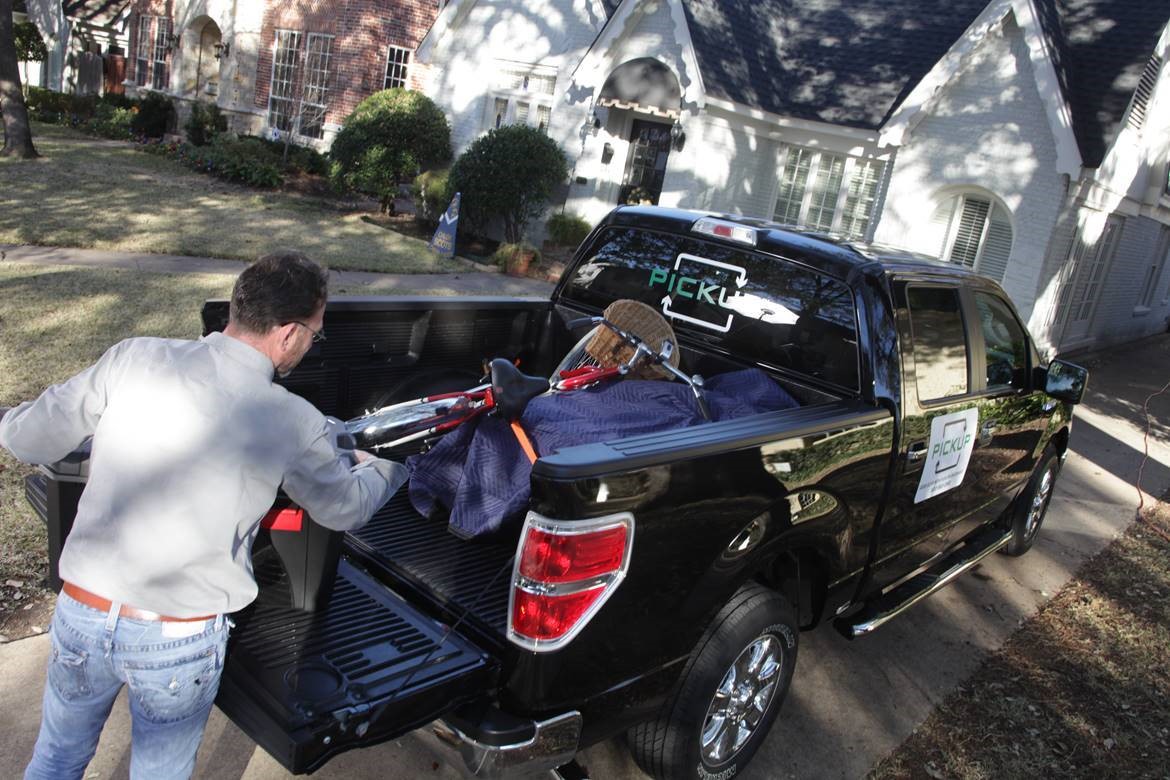Loads For Pickup Trucks: A Comprehensive Guide to Maximizing Your Truck’s Potential pickup.truckstrend.com
Introduction: The Backbone of Utility
The pickup truck is an icon of utility, a versatile workhorse designed to carry, tow, and conquer tasks that other vehicles simply can’t. At the heart of its capability lies its ability to haul "loads" – anything from a week’s groceries to a ton of gravel. Understanding how to properly manage loads for pickup trucks is not just about getting the job done; it’s about ensuring safety, maximizing efficiency, preserving the life of your vehicle, and complying with legal requirements. Whether you’re a weekend warrior tackling home projects, a small business owner moving equipment, or an adventurer hauling gear, mastering the art of loading your truck is paramount. This comprehensive guide will delve into every aspect of hauling loads, transforming your pickup from a simple vehicle into a truly optimized work and leisure partner.
Loads For Pickup Trucks: A Comprehensive Guide to Maximizing Your Truck’s Potential
Understanding Your Truck’s Capacity: The Foundation of Safe Hauling
Before you even think about tossing anything into your truck bed, the first and most critical step is to understand your vehicle’s limitations. Every pickup truck is engineered with specific weight capacities that dictate how much it can safely carry. Exceeding these limits is not only illegal in many jurisdictions but also incredibly dangerous, leading to compromised handling, extended braking distances, accelerated wear and tear, and potential catastrophic failure.
- Payload Capacity: This is the maximum weight your truck can carry in its cab and bed, including passengers, fuel, and cargo. It’s calculated by subtracting the truck’s "curb weight" (its weight with a full tank of fuel but no passengers or cargo) from its "Gross Vehicle Weight Rating" (GVWR). You can typically find your truck’s payload capacity listed on a sticker inside the driver’s side door jamb or in the owner’s manual.
- Gross Vehicle Weight Rating (GVWR): The maximum permissible total weight of the truck itself, including the vehicle, all fluids, passengers, and cargo. This is the absolute maximum weight your fully loaded truck should ever be.
- Gross Axle Weight Rating (GAWR): This specifies the maximum weight that can be supported by each axle (front and rear). Proper load distribution is essential to ensure you don’t exceed the GAWR for either axle, even if you’re within your overall payload capacity.
- Towing Capacity: While distinct from payload, towing capacity is related. It refers to the maximum weight your truck can pull in a trailer. While not directly about bed loads, it’s part of your truck’s overall hauling capability.

Practical Advice: Always err on the side of caution. If you’re unsure of your load’s weight, use a public scale (often found at truck stops or recycling centers) to weigh your loaded truck and compare it to your GVWR. Remember, every pound counts – even passengers and their gear contribute to the payload.
Types of Loads: What Can You Haul Effectively?
The versatility of a pickup truck means it can handle an astonishing variety of loads. Understanding the characteristics of different load types will help you prepare and secure them appropriately.
- Everyday & Recreational Loads: These often include groceries, luggage, camping gear, sports equipment (bikes, kayaks), or small tools. They are typically lighter and easier to manage, often fitting well within capacity limits.
- DIY & Home Improvement Loads: Lumber, drywall sheets, bags of concrete mix, topsoil, mulch, furniture, appliances, and construction debris are common. These loads can quickly add up in weight and often require careful stacking and securing due to their size and shape.
- Work & Commercial Loads: For contractors, landscapers, or farmers, this might involve heavy machinery components, large quantities of raw materials (sand, gravel, stone), commercial tools, or agricultural products. These loads frequently push the limits of a truck’s capacity and demand professional-grade securing methods.
- Irregular & Oversized Loads: While most pickups are not designed for true "oversized" transport requiring special permits, they often carry items that are long (lumber, pipes), wide (sheet goods), or awkwardly shaped (appliances, tree stumps). These require special attention to ensure they don’t shift, obstruct visibility, or create a hazard.

Key Consideration: The density and shape of a load are as important as its total weight. A truck bed full of feathers might weigh less than a half-bed of gravel, but both present unique challenges for containment and distribution.

Essential Equipment for Safe & Effective Loading
Proper equipment is non-negotiable for safe and efficient load management. Investing in the right tools protects your cargo, your truck, and others on the road.
- Bed Liners and Mats: A drop-in or spray-on bed liner protects your truck bed from scratches, dents, and rust caused by shifting cargo. Rubber bed mats add an extra layer of protection and prevent items from sliding around.
- Tie-Downs:
- Ratchet Straps: The gold standard for securing heavy or bulky loads. They provide superior tension and hold compared to ropes or bungee cords. Ensure they are rated for the weight of your cargo.
- Cam Buckle Straps: Good for lighter loads where less tension is needed.
- Bungee Cords: Useful for light items or bundling, but never rely on them for primary load securement. They stretch and can snap back dangerously.
- Cargo Management Systems:
- Cargo Bars/Load Dividers: These extend across the bed to prevent items from sliding forward or backward.
- Cargo Nets: Excellent for containing multiple smaller items or preventing loose debris from flying out.
- Bed Extenders: Allow you to safely carry longer items by extending the bed length when the tailgate is down.
- Loading Ramps: Essential for safely loading wheeled items like ATVs, lawnmowers, motorcycles, or dollies with heavy appliances. Choose ramps with adequate weight capacity and a non-slip surface.
- Tarps/Covers: Protect sensitive cargo from weather elements (rain, sun) and prevent loose materials (mulch, leaves) from blowing out of the bed.
- Toolboxes/Storage Solutions: Keep your tools and small items organized and secure, preventing them from becoming projectiles.
Best Practices for Loading Your Pickup Truck
Once you have the right equipment, applying proper loading techniques is crucial.
- Distribute Weight Evenly and Low:
- Place the heaviest items directly over or slightly forward of the rear axle. This helps maintain proper balance and traction.
- Keep the center of gravity as low as possible. Stack heavy items at the bottom and lighter items on top.
- Avoid concentrating all weight on one side of the bed, which can lead to instability and uneven tire wear.
- Secure the Load Comprehensively:
- Tie-Down Points: Use all available tie-down points in your truck bed.
- "X" Pattern: For large, heavy items, use straps in an "X" pattern across the item to prevent movement in multiple directions.
- Multiple Straps: Don’t rely on just one strap. Use at least two for any significant item, ideally four for large objects to prevent rotation or shifting.
- Check for Slack: After securing, tug on the load and re-tighten straps if necessary. Check again after driving a short distance.
- No Overhang: If an item extends beyond the tailgate, it must be properly flagged (red or orange flag) during the day and have red lights at night. Check local regulations for maximum allowable overhang.
- Maintain Visibility: Ensure your load does not obstruct your rearview mirror, side mirrors, or brake lights. If it does, consider mirror extensions or adjust your driving accordingly.
- Pre-Trip Inspection: Before heading out, perform a quick check:
- Tires: Ensure tires are properly inflated for the loaded weight (check owner’s manual or tire placard for recommended pressures).
- Lights: Verify all lights (headlights, tail lights, brake lights, turn signals) are visible and functioning.
- Suspension: Check for excessive sag, which indicates overloading or a need for suspension upgrades.
- Load Security: Give everything a final tug.
- Adjust Your Driving: A loaded truck handles differently.
- Increased Braking Distance: Allow significantly more room to stop.
- Wider Turns: Account for the altered center of gravity and potential overhang.
- Slower Speeds: Reduce your speed, especially on curves, rough roads, or windy conditions.
- Less Aggressive Maneuvers: Avoid sudden braking, sharp turns, or rapid acceleration.
Common Challenges and Solutions
Hauling loads comes with its share of potential pitfalls. Being aware of them allows for proactive solutions.
- Overloading:
- Challenge: Dangerously compromises handling, braking, and accelerates wear on suspension, tires, and drivetrain. Illegal and can result in fines.
- Solution: Always know your truck’s payload capacity. When in doubt, weigh your truck. If you frequently haul heavy loads, consider a heavy-duty truck or suspension upgrades (like airbags).
- Shifting Loads:
- Challenge: A load that shifts can cause loss of control, damage to the truck or cargo, or become a dangerous projectile.
- Solution: Use adequate and properly rated tie-downs. Employ multiple securing points and methods (e.g., straps and cargo nets). Block gaps with wood or other material to prevent sliding.
- Damage to Truck Bed:
- Challenge: Scratches, dents, and rust can quickly degrade your truck bed’s condition and resale value.
- Solution: Always use a bed liner or mat. Place cardboard or old blankets under heavy or sharp objects.
- Poor Visibility:
- Challenge: A tall or wide load can block your mirrors, creating blind spots.
- Solution: Load strategically to keep the rear window and mirrors clear. Use extended mirrors if necessary. Drive with extreme caution and be extra vigilant when changing lanes or backing up.
- Securing Irregular Shapes:
- Challenge: Items like appliances, furniture, or machinery often have awkward shapes that are hard to strap down.
- Solution: Use padding to protect edges and fill voids. Employ multiple straps in various directions (e.g., over the top, diagonally) to cradle the item. Use wood blocks or dunnage to prevent sliding.
Cost Considerations for Hauling Different Types of Loads & Equipment
While there isn’t a fixed "price" for hauling loads, there are significant cost implications related to equipment, fuel, and potential issues.
| Category / Item | Description | Estimated Cost Range (USD) | Implication / Benefit |
|---|---|---|---|
| Fuel Consumption (Added) | Heavier loads significantly reduce fuel efficiency. | $0.10 – $0.30 per mile | Direct operational cost; heavier loads increase fuel spend. |
| Bed Liner (Drop-in/Spray) | Protects truck bed from scratches, dents, and corrosion. | $150 – $800 | Prevents costly bed repairs and maintains resale value. |
| Ratchet Straps (Set of 4) | Essential for securing various loads safely. | $30 – $100 | Crucial for safety and preventing cargo damage/loss. |
| Cargo Net / Tarp | Secures loose items, protects from elements. | $20 – $150 | Prevents debris from flying out, protects cargo from weather. |
| Loading Ramps (Pair) | For safe loading of wheeled items like ATVs, mowers, or heavy dollies. | $100 – $400 | Enables safe and easy loading of heavy, wheeled equipment. |
| Tire Air Compressor | Essential for maintaining proper tire pressure for loaded trucks. | $50 – $200 | Improves fuel efficiency, extends tire life, enhances safety. |
| Suspension Upgrades | (e.g., Airbags, Helper Springs) For frequent heavy hauling, reduces sag, improves stability. | $300 – $1000+ (parts only) | Enhances ride quality, stability, and load-carrying capacity. |
| Overload Fines / Accidents | Potential cost of exceeding weight limits or accidents due to unsecured loads. | $100 – $Thousands | Legal penalties, insurance premium increases, repair costs. (Prevention is key) |
| Professional Hauling Service | If a load is too big/heavy for your truck or you lack equipment. | $50 – $500+ (per job) | Option when personal truck capacity is exceeded or specialized transport is needed. |
Frequently Asked Questions (FAQ)
Q1: How do I find my truck’s payload capacity?
A1: Look for a sticker on the driver’s side door jamb, often labeled "Tire and Loading Information." It will list the maximum weight for occupants and cargo. You can also find this information in your truck’s owner’s manual.
Q2: Is it okay to exceed my truck’s payload capacity occasionally?
A2: No. Exceeding your truck’s payload capacity, even occasionally, is highly dangerous. It compromises braking and handling, puts excessive strain on your suspension, tires, and drivetrain, and can lead to serious accidents or costly mechanical failures. It can also void your warranty or result in fines.
Q3: What’s the best way to secure a bulky, odd-shaped load like a refrigerator?
A3: Use heavy-duty ratchet straps. Place the refrigerator as close to the cab and centered as possible. Use old blankets or cardboard to protect the appliance and your truck bed. Wrap straps around the appliance and secure them to multiple tie-down points in an "X" pattern for maximum stability, ensuring the straps are taut. Consider using wood blocks or dunnage to prevent sliding.
Q4: Do I need special tires for hauling heavy loads?
A4: Most light-duty pickup trucks come with "P-metric" (passenger car) tires. If you frequently haul near your truck’s maximum payload, upgrading to "LT" (light truck) tires can offer better load-carrying capacity, durability, and stability. Always ensure your tires are inflated to the proper pressure for loaded conditions, as specified in your owner’s manual or door jamb sticker.
Q5: How does a heavy load affect my truck’s braking?
A5: A heavy load significantly increases your truck’s stopping distance. The added weight means more momentum, requiring more force and time to slow down. Always allow much greater following distances and begin braking earlier when hauling heavy loads. Your brakes will also experience more wear.
Q6: Can I haul dirt or gravel in my truck bed?
A6: Yes, but be mindful of the weight. Dirt, sand, and gravel are very dense materials. Even a half-full bed can easily exceed your truck’s payload capacity. Use a bed liner or tarp to protect your bed, and secure the load with a tarp to prevent material from blowing out. Know the weight of the material per cubic foot to estimate if it’s within your limits.
Conclusion: Empowering Your Pickup’s Potential
Your pickup truck is an incredibly capable machine, but its true potential is unlocked only when you understand and respect the principles of proper load management. From knowing your vehicle’s capacities and investing in essential equipment to mastering best practices for securing diverse cargo, every step contributes to a safer, more efficient, and longer-lasting hauling experience. By treating your truck as the versatile tool it is and approaching each load with knowledge and preparation, you not only protect your investment but also ensure the safety of yourself and everyone on the road. Embrace the art of the load, and your pickup will serve you reliably for years to come.



